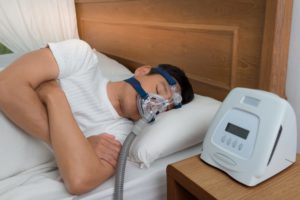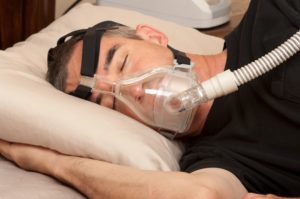When you buy through our links, we may earn a commission. Products or services may be offered by an affiliated entity. Learn more.
Micrognathia and Obstructive Sleep Apnea
Micrognathia is a condition where a child is born with a smaller than normal lower jaw. The condition can create problems with feeding and breathing. The breathing problems may manifest as obstructive sleep apnea (OSA), a sleep disorder that lowers energy levels and overall quality of life. OSA is relatively uncommon among the general population but is highly prevalent among individuals with micrognathia. Nearly 88% of children with micrognathia may have severe OSA.
What Is Micrognathia?
Micrognathia, also known as mandibular hypoplasia , is a condition where a person has a lower jaw that’s much smaller than the rest of their face, creating the appearance of an overbite. The definition for micrognathia translates to “ small mandible “, as mandible is the word for the lower jaw.
Beyond the appearance of the small jaw, symptoms of micrognathia include difficulty feeding or breathing, pauses in breathing (an indicator of sleep apnea), hearing problems , and trouble sleeping. Around 84% of children with micrognathia may have difficulty feeding, while 88% have sleep apnea. Gastroesophageal reflux is also more common among people with micrognathia.
Micrognathia may resolve on its own as the child grows, particularly during puberty . While the condition is still present, however, micrognathia can cause complications that affect development. The infant may have difficulty feeding, their teeth may not grow properly, and they may have trouble breathing, leading to obstructive sleep apnea.
Understand Your Sleep Apnea Risk
Answer three questions to take charge of troubled sleep.
Micrognathia and Obstructive Sleep Apnea
Obstructive sleep apnea (OSA) causes temporary lapses in breathing during sleep, disrupting a person’s sleep quality and increasing their risk for adverse cardiovascular, neurobehavioral, and metabolic conditions . OSA occurs when the airways are blocked during sleep, causing choking, gasping, or loud snoring sounds. Even if the person doesn’t wake up during an apneic episode, their sleep quality suffers and causes symptoms of sleep deprivation like impaired mood, focus, and energy.
In cases of pediatric OSA, sleep deprivation can lead to an increase in headaches, hyperactivity, and learning and behavior problems. OSA also lowers blood oxygen saturation levels below 90% , which may impact the growth of children with this disorder.
OSA can develop from a physical condition, such as obesity, enlarged tonsils, or micrognathia. With micrognathia, the smaller size of the lower jaw causes the person’s tongue to fall backward, blocking the airway and causing symptoms of sleep apnea.
The severity of OSA is measured by the number of apneic episodes a person experiences through the night. Children with micrognathia not only have a significantly higher risk of sleep apnea overall, but they are also more likely to have a severe case of OSA. The average child experiences only three apneic episodes per hour, while a child with micrognathia experiences 20, a nearly sevenfold increase.
Causes of Micrognathia
Most children with micrognathia are born with it. Micrognathia may be caused by over 700 genetic mutations or inherited conditions that cause craniofacial abnormalities like small lower jaws, including:
- Achondrogenesis
- Cleft lip or palate
- Cri du chat syndrome
- Fetal alcohol syndrome
- Hallermann-Streiff syndrome
- Goldenhar syndrome
- Melnick Needles syndrome
- Marfan syndrome
- Nagar syndrome
- Pierre Robin sequence
- Progeria
- Russell-Silver syndrome
- Seckel syndrome
- Smith-Lemli-Opitz syndrome
- Treacher-Collins syndrome
- Trisomy 9
- Trisomy 13
- Trisomy 18
- XO syndrome
Many of the genetic conditions that cause micrognathia are rare. For example, Pierre Robin sequence affects 1 out of every 8,500 to 14,000 newborns , while 1 in 16,000 babies has trisomy.

How Is Micrognathia Diagnosed?
Micrognathia is typically diagnosed during infancy, if not sooner. In many cases, micrognathia can be detected via ultrasound in the first trimester of pregnancy.
If your child’s jaw looks small, or you notice they have trouble feeding or breathing, talk to your pediatrician. As your child grows, they may continue having trouble eating or speaking, due to the misalignment of their teeth. If they have sleep apnea, your child may have difficulty sleeping, or be especially hyperactive or tired during the day. You may notice them making choking, gasping, or loud snoring sounds during their sleep.
When diagnosing micrognathia, your doctor will begin with a physical exam of your child to assess the size of their lower jaw relative to their upper jaw, and the position of their tongue and lower jaw. Your doctor may order an X-ray or CT scan to further analyze the anatomical relationship between your child’s lower jaw and the rest of their head. Your doctor may also ask you questions about when you first noticed the size of your child’s jaw, the severity of their symptoms, and whether they have difficulty eating or breathing.
If your child exhibits signs of sleep apnea, your doctor may order a polysomnogram, also known as an overnight sleep study. During this exam, your child will sleep in a lab while doctors monitor their breathing, brainwaves, blood oxygen levels, and heart rate as they sleep.
Treatment Options for Micrognathia
Treatments for micrognathia depend on the severity of the condition and the underlying cause. Micrognathia may go away on its own as the child’s jaw grows with age. For this reason, some parents may choose to delay treatment to see if the problem resolves naturally.
More immediate treatment may be required for severe cases that cause feeding or breathing difficulties, as well as misalignment of the teeth. A doctor may recommend different feeding positions to help an infant with feeding problems. For breathing problems, continuous positive airway pressure (CPAP) therapy or oral surgery can be effective.
CPAP Therapy
For sleep apnea symptoms, your doctor may recommend different sleep positions that allow for easier breathing, or they may prescribe CPAP therapy. CPAP machines keep the airways open by delivering pressurized air into the mouth via a face mask connected to the machine.
In a study of adolescents and young adults with micrognathia, CPAP therapy significantly reduced sleep apnea symptoms. CPAP therapy is intended to be temporary, and is less effective when used in a person where the airway is physically blocked by enlarged tissues. In these cases, CPAP therapy may reveal the need for corrective surgery instead.
Mandibular Distraction Surgery
Doctors may recommend various types of oral surgery to clear the airways, depending on the severity and the cause of a person’s micrognathia. Misalignment of the teeth may be treated with orthodontic braces or oral surgery. Tongue-lip adhesion can move the base of the tongue forward, while mandibular distraction osteogenesis (MDO) surgery gradually extends the lower jaw by adding or removing bone.
It takes time to heal from these surgeries, but they’re generally successful. Feeding and breathing problems should resolve within a few months to a year and a half . Symptoms of sleep apnea should also significantly improve after surgery. Individuals experience fewer apneic episodes, and their blood oxygen saturation levels improve or return to healthy levels.
In a study of adults with micrognathia, MDO surgery resolved sleep apnea for over 80% of participants and significantly improved symptoms for the remainder. A study of infants produced similar results , with MDO surgery either significantly improving sleep apnea symptoms or eliminating them entirely. Tongue-lip adhesion has also been shown to either significantly decrease or resolve sleep apnea symptoms.
Early diagnosis provides the best outlook for micrognathia. The sooner the condition is diagnosed, the better a doctor can determine what treatments, if any, are needed.

Still have questions? Ask our community!
Join our Sleep Care Community — a trusted hub of sleep health professionals, product specialists, and people just like you. Whether you need expert sleep advice for your insomnia or you’re searching for the perfect mattress, we’ve got you covered. Get personalized guidance from the experts who know sleep best.
References
12 Sources
-
Sedaghat, A. R., Anderson, I. C., McGinley, B. M., Rossberg, M. I., Redett, R. J., & Ishman, S. L. (2012). Characterization of obstructive sleep apnea before and after tongue-lip adhesion in children with micrognathia. The Cleft Palate-Craniofacial Journal: Official Publication of the American Cleft Palate-Craniofacial Association, 49(1), 21–26.
https://pubmed.ncbi.nlm.nih.gov/21495918/ -
Miller, S. D., Glynn, S. F., Kiely, J. L., & McNicholas, W. T. (2010). The role of nasal CPAP in obstructive sleep apnoea syndrome due to mandibular hypoplasia. Respirology (Carlton, Vic.), 15(2), 377–379.
https://pubmed.ncbi.nlm.nih.gov/20199649/ -
Boyadjiev Boyd, S. A. (2020, May). Merck Manual Consumer Version: Jaw Defects., Retrieved May 5, 2021, from
https://www.merckmanuals.com/home/children-s-health-issues/birth-defects-of-the-face,-bones,-joints,-and-muscles/jaw-defects -
Society for Maternal-Fetal Medicine, Benacerraf, B. R., Bromley, B., & Jelin, A. C. (2019). Micrognathia. American Journal of Obstetrics and Gynecology, 221(5), B13–B15.
https://pubmed.ncbi.nlm.nih.gov/31679587/ -
Boyadjiev Boyd, S. A. (2020, May). Merck Manual Professional Version: Congenital Jaw Abnormalities., Retrieved May 5, 2021, from
https://www.merckmanuals.com/professional/pediatrics/congenital-craniofacial-and-musculoskeletal-abnormalities/congenital-jaw-abnormalities -
A.D.A.M. Medical Encyclopedia. (2019, May 17). Micrognathia., Retrieved May 5, 2021, from
https://medlineplus.gov/ency/article/003306.htm -
Capdevila, O. S., Kheirandish-Gozal, L., Dayyat, E., & Gozal, D. (2008). Pediatric obstructive sleep apnea: complications, management, and long-term outcomes. Proceedings of the American Thoracic Society, 5(2), 274–282.
https://pubmed.ncbi.nlm.nih.gov/18250221/ -
Landsberg, R., Friedman, M., & Ascher-Landsberg, J. (2001). Treatment of hypoxemia in obstructive sleep apnea. American Journal of Rhinology, 15(5), 311–313.
https://pubmed.ncbi.nlm.nih.gov/11732817/ -
A.D.A.M. Medical Encyclopedia. (2016, December 1). Isolated Pierre Robin sequence., Retrieved May 5, 2021, from
https://medlineplus.gov/genetics/condition/isolated-pierre-robin-sequence/ -
A.D.A.M. Medical Encyclopedia. (2013, November 1). Trisomy 13., Retrieved May 5, 2021, from
https://medlineplus.gov/genetics/condition/trisomy-13/ -
Wang, X., Wang, X. X., Liang, C., Yi, B., Lin, Y., & Li, Z. L. (2003). Distraction osteogenesis in correction of micrognathia accompanying obstructive sleep apnea syndrome. Plastic and Reconstructive Surgery, 112(6), 1549–1559.
https://pubmed.ncbi.nlm.nih.gov/14578784/ -
Wittenborn, W., Panchal, J., Marsh, J. L., Sekar, K. C., & Gurley, J. (2004). Neonatal distraction surgery for micrognathia reduces obstructive apnea and the need for tracheotomy. The Journal of Craniofacial Surgery, 15(4), 623–630.
https://pubmed.ncbi.nlm.nih.gov/15213542/






















































